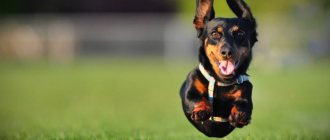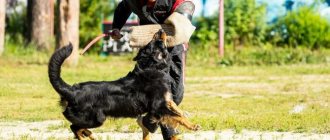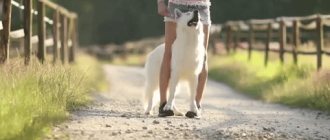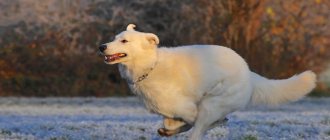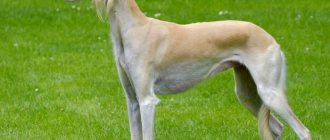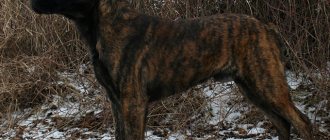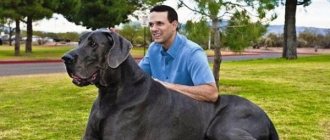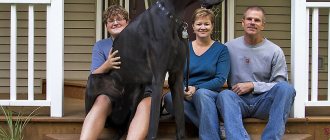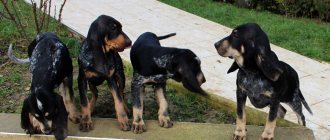Home » Dog Breeds
Classification Origin: Hungary
Class: according to accepted FCI standards, the breed is classified in group 1 (guard and driving dogs, with the exception of Swiss snow dogs)
Section 1: herding dogs. No operational tests
Application: as a pet, for protection and as a herding dog
Dimensions: Male height – 71-76 cm; female height – 66-70 cm; male weight – 48-62 kg; female weight – 37-50 kg
Lifespan: 10 to 12 years
The Kuvasz is a beautiful dog that has courage, strength and an extraordinary sense of freedom. She loves movement, becomes very attached to her owner and is ready to protect him at any time.
Kuvasz is a fairly ancient breed of dog that was used by shepherds along with Beaucerons , Kangals , Groenendaels and Hovawarts .
At its core, it is a rather unpretentious and hardy dog that copes well with guarding livestock.
Today it is not only a shepherd breed. Kuvasz is a wonderful companion and a great friend for any family member.
Punishment in the form of being locked in a cage or chain can lead to depression or aggression in a dog
- 2 Character and behavioral characteristics
- 3 Application
- 4 Kuvasz puppies: what to look for when choosing?
- 5 Features of care
- 6 Walking
- 7 Feeding
- 8 Health
- 9 Characteristic diseases of the breed
- 10 Vaccinations
- 11 Mating
History of the breed
For some time, there was quite a lot of controversy about the origin of this breed. Someone was inclined to believe that the dog appeared in the Carpathian Basin region along with Komondors (Hungarian shepherd dogs).
Indeed, since ancient times, the Hungarian Kuvasz together with the Komondors have been mentioned as two types of breeds that are reliable guards and faithful helpers in the pasture.
Important! In ancient times, shepherds tried to choose only those dogs whose color was completely snow-white. This was done for the reason that in the dark, gray-colored individuals could easily be confused with a predatory animal.
This breed became most popular during the reign of Matt Corvinus (15th century). The king loved these dogs so much that he was constantly surrounded by them.
At the same time, the highest sign of praise for any person from the monarch was a gift in the form of a Kuvasz puppy.
The Hungarian kuvasz was first exhibited in Hamburg at the end of the 19th century. Reliability and good security qualities were appreciated.
After this, the dog breed was increasingly found in the private homes of city residents.
However, after the end of the First World War, there was a very strong decline in this breed.
According to statistics, only about three dozen individuals remain in the homeland of the Kuvasz, Hungary. And only thanks to connoisseurs, this breed was gradually reborn from the ashes.
The article will tell you about other rare and endangered dog breeds
Disqualifying faults
Unfortunately, cases cannot be ruled out when puppies are born with some kind of defects. Such dogs are not allowed for further breeding, so as not to spoil the breed standards. The vices of dogs include:
- snack,
- too sharp a transition from forehead to muzzle,
- increased hardness of the coat,
- curled or too raised tail,
- creases and bends of the tail,
- color is not according to standard.
Attention! Dogs with excess body weight - more than 70 kg - are also not accepted for breeding. Dogs with short stature will also be rejected - below the smallest limit.
Character and behavioral characteristics
This breed combines many good qualities:
- mind;
- calmness and balance;
- understanding;
- friendliness.
However, this dog requires constant attention. After all, behavior problems are often caused precisely by a lack of time for a pet or a lack of knowledge regarding training.
Important! If you want your Kuvasz to be kind and confident, you should not put him on a chain. This can cause the dog to become aggressive or even depressed.
Training requires a lot of time and patience. However, after it expires, you will be rewarded - you will always have a faithful and brave comrade with you, capable of standing up for you.
The result largely depends on how well you explained your desire to the dog. If she understands you, she will gladly carry out the command.
Kuvasz loves when her owner talks to her. The more often such contact occurs, the better she will understand commands.
The “herding” genes in the Hungarian Kuvasz are reflected in an incredible love of walking. However, at home he is a calm and friendly companion.
Price
The price of a Hungarian Kuvasz puppy varies over a fairly wide range. In Russia and the CIS countries, kuvasz is a rarity, which allows breeders to maintain the cost at a high level: 35,000-50,000 rubles. In Hungary and neighboring countries, where the breed is more common, a puppy from working parents can be bought for 20,000-25,000 thousand rubles. Promising Kuvasz babies for exhibitions and breeding will cost 2-3 times more. It is not uncommon to find advertisements for the sale of puppies without a pedigree, at a symbolic price.
Application
If previously the Hungarian Kuvasz was a shepherd dog, now it is a pet, a wonderful companion, and a reliable guard.
Thanks to his character, which is not inferior to the Australian Shepherd , he gets along easily with children.
A photo of this breed evokes affection and instant sympathy. However, this cute pet bravely stands up for its owner and is unlikely to allow a stranger into its territory
Important! Since this breed is independent, it requires a skilled and experienced owner, as training can take quite a long time.
Kuvasz loves communication very much. Therefore, you can talk to him, and this will only strengthen the connection between the dog and the owner.
Training
The breed requires long and hard training, which should be entrusted to a specialist. Kuvasz has a self-sufficient, independent character and therefore will obey only a strong, authoritative owner. A dog needs affection and love from its owner. The baby begins to be socialized from the first days of his life in the house, accustoming him to his surroundings.
From four months they begin to go to the training ground, where the puppy learns to communicate with other animals and clearly sees the training process from their example and learns obedience. By the age of three, the Hungarian Kuvasz must be fully educated and trained. They recommend methodical education and training in a way of motivating and rewarding success, without raising your voice or using physical punishment.
Kuvasz puppies: what to look for when choosing?
When you first see a photo of a small Kuvasz, the question of whether or not to purchase this cute canine representative disappears by itself.
Actually, how can you not want this cute snow-white bear cub as a pet?
When choosing puppies, it is best to pay attention to representatives several months old. Thus, the new family member gets used to new conditions and the owner from infancy.
Important! There is an opinion that the kuvasz chooses its owner. Often this becomes a male representative, since the Hungarian Kuvasz agrees to obey only a strong person with a strong character.
The behavior of this dog largely depends on how it is handled and kept. Therefore, the owner must be a responsible person who has enough time to train, raise and care for the dog.
When purchasing, it is best to contact reliable breeders and nurseries. This ensures that in addition to the puppy, you can examine the parents, obtain the necessary documents, and also enlist the support of specialists.
How to choose a puppy
There are still very few Kuvasz dogs in the post-Soviet space, and the first breeding nurseries began to appear only ten years ago. An exclusive puppy produced by them is quite expensive - on average, $1,200, and a promising baby will cost an even larger amount. It makes sense to buy a small kuvasz in Hungary - its cost, including delivery, will be lower, and the choice will be much greater.
Choosing the right Kuvasz puppy is not easy.
In the historical homeland of the Kuvasz, it is quite possible to find a puppy with show potential and interesting bloodlines for 600–700 dollars, and an excellent working dog for 300–400.
To avoid becoming a victim of scammers, such a purchase cannot be made privately - on the market or through an advertisement on the Internet. Only in a reputable breeding nursery and only under an agreement with the breeder - this will guarantee the breed of the puppy and its health. What you should pay attention to when choosing, so as not to get a cute white mongrel instead of an exclusive kuvasz:
- on the head - study the standard, the Kuvasz head parameters are unique (a wide skull with an elongated muzzle, a soft “stop”, slightly slanted eyes and slightly raised ears on the cartilage);
- in terms of body proportions - a small kuvasz looks like an “ugly duckling”; up to six months it has a disproportionately large head and thin legs;
- on the coat - even in puppyhood, the Kuvasz has a special coat, moderately hard and wavy, with abundant down;
- on pigment - as for a white dog, the Kuvasz has excessive pigmentation (black nose, dark spots on the palate and gums, gray skin).
Features of care
Proper maintenance and care of your Kuvasz is the key to ensuring that the dog will always obey and behave adequately.
Kuvasz has a fairly long coat, which is also white in color. Regular brushing is what this breed needs first and foremost.
The coat does not need to be trimmed or cut, but during shedding it is worth using a furminator .
The fur on the paws and face is shorter. In other places it is longer. The coat can be either straight or wavy.
Important! Grooming takes a lot of time. Especially in the autumn and spring periods, when dogs shed heavily.
Dogs that live in an enclosure shed twice a year. But for individuals who live in apartments, this process can practically never stop.
This white Hungarian miracle will be a wonderful companion
Dossier
Height of an adult: females - 66-70 cm, males - 70-76 cm. Weight: females - up to 52 kg, males - up to 60 kg. Characteristic color: white. Coat length: long, up to 15 cm. Life expectancy: 10-12 years. Advantages of the breed: loyalty, fearlessness, moderate temperament, friendliness, high intelligence. Difficulties of the breed: long training. Average price: 600-1400 US dollars. Classification: large breed, service, working, guard, herding, companion.
Walk
If you have decided to get a dog, and your home is an apartment, you need to seriously think about whether the dog will be provided with the necessary level of activity.
After all, an ordinary apartment will hardly be a dog’s favorite place. In this case, the dog should be walked for at least two hours, active games such as agility .
A dog's development stops at about 1-1.5 years
The best place for keeping would be a country house with a spacious enclosure and a yard, where the Kuvasz can frolic and, at the same time, protect its owners. The dog's enclosure should be spacious. It needs to be cleaned daily.
If you live in an apartment, we recommend choosing a breed from the list in the article
Important! Kuvasz are very fond of freedom and running. Therefore, the best place to keep it is a spacious private house with a large area (yard or garden).
For a walk, it’s best to bring a couple of your favorite toys that will help you do a few exercises and let your dog off some steam.
Reviews from dog owners
Andrey. I was looking for a puppy for a long time, bought it in Orenburg, in a nursery. I needed a dog to guard a vineyard that was constantly being raided by local thieves. I bought a male dog, he grew up right on the farm, every day I walked around the territory with Dean. The very next year they were afraid to come closer than a hundred meters to my vineyard! One sight of a silent, white guard of an unknown breed sent those wishing to get hold of other people's goods for free into flight.
Michael. I read about Hungarian kuvasz on the Internet and wanted to buy such a miracle. They wrote that the dog is silent, loves children and completely obeys his owner. It turned out that Nemo is aggressive towards strangers, stubborn and willful, avoids children, and can drop a child while running past. Of course, he doesn’t bark, he guards the yard well, but he’s not particularly sociable. My wife complains that the yard is constantly littered with wool. Apparently, this breed needs will, not a country house.
Video
Feeding
Proper feeding is the key to good health for your pet. When preparing your kuvasz’s diet yourself, you need to carefully monitor the amount of energy-intensive nutrients.
They must be given in a certain proportion, which differs depending on the age of the dog.
Otherwise, if the diet is not balanced (this is especially important for puppies), pathologies of internal organs may develop and digestive system disorders may appear.
If this occurs in puppyhood, treatment as an adult is not possible.
Important! If your kuvasz begins to listen poorly or is reluctant to follow commands, perhaps the reason lies in unsuitable food or living conditions. These dogs love freedom and space.
Prepared feeds can also be used as food. They contain balanced nutrients and vitamins, so no supplements are needed.
If you cannot decide what is better to feed your dog: food or natural food, we recommend reading the article
Additional dosages of the vitamin are prescribed by a specialist one-time for a specific animal only if individual characteristics in metabolism are observed.
Overfeeding leads to deterioration of the condition of loose connective tissues, excess weight, as well as weakening of ligaments and the entire skeleton.
Characteristic diseases of the breed
This breed is prone to hip dysplasia, as are most large breeds.
Important! Joint diseases can begin to develop at a young age. Therefore, you need to make sure that the puppies are not too active until their musculoskeletal system is fully formed. Excessive loads can cause it to deform.
Otherwise, this breed will delight its owner in terms of health. She is harmoniously built, resilient and strong. Has no problems with the spine.
And trips to the veterinarian, with proper maintenance, nutrition and care, will only be made for regular preventive deworming or vaccination against infectious diseases.
Sometimes there are cases when Kuvasz suffers from osteochondrosis dissecans. This disease is manifested by lameness due to the fact that the shoulder joint is inflamed.
There are also cases of hypertrophic osteodystrophy, skin problems and allergic reactions.
Vaccinations
Infectious diseases can be caused in kuvasz by various viruses and bacteria. In order to exclude this possibility, vaccinations are performed in veterinary clinics.
Preventive vaccinations are given periodically throughout the pet's life. The vaccination repetition period is 1 year.
A separate vaccination against rabies is given.
Important! Attention, affection and company of the owner are as important for the Kuvasz as food and walks. Never deprive him of these joys.
Before any vaccination is carried out, the veterinarian must carefully examine the animal. The dog should feel well, be completely healthy, and the temperature should be within normal limits.
Deworming is carried out in advance (10 days) before vaccination.
Let's play some more? You've only been walking for a couple of hours... No? Or maybe a ball?
Appearance
The Hungarian Kuvasz is a large dog.
She has a very thick, slightly wavy coat.
She moves confidently, visually a little proudly.
Weight – in the range of 43-55 kg for males, for females – 33-41 kg. At the withers the height of a male is from 70 to 76 cm, and that of a female is 65-70 cm. The dog’s head is wedge-shaped. Compared to the overall body size, it is small. Tapered towards the nose. The transition between the forehead and muzzle is moderate. The brow ridges are developed.
The eyes are almond-shaped, slightly protruding, widely set.
Eye color – brown, dark shades.
The ears are triangular and drooping. They fit tightly to the head. The ear is approximately half the length of the head.
The muzzle is quite long, accounting for approximately half of the total length of the head.
The nose is black and large.
Strong jaws with a scissor bite.
A strong and muscular neck, smoothly turning into the withers. The chest is of moderate width, the ribs are slightly convex. The back is short, the stomach is tucked, the lower back is rounded.
Limbs are strong. The front ones are straight, set parallel. The paw is in a tight ball.
The coat is thick and soft, from 4 to 14 cm long. The undercoat is thick and dense. On the body and tail – wavy. There are fringes on the limbs. The longest hair is on the tail (from 10 cm).
Color white or ivory.

